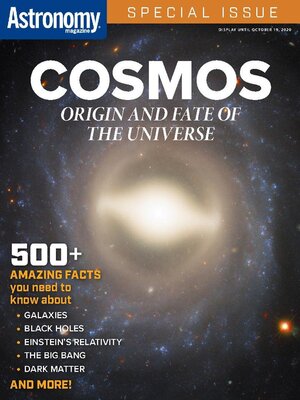Cosmos: Origin and Fate of the Universe
magazine ∣ Cosmos: Origin and Fate of the Universe · Cosmos: Origin and Fate of the Universe

Sign up to save your library
With an OverDrive account, you can save your favorite libraries for at-a-glance information about availability. Find out more about OverDrive accounts.
Find this title in Libby, the library reading app by OverDrive.



Search for a digital library with this title
Title found at these libraries:
| Library Name | Distance |
|---|---|
| Loading... |
Features: • The Universe of Galaxies – See how we’ve come to learn so much about our home galaxy and other galaxies. • Relativity – Black holes are being used to test the rules of Einstein’s theory of relativity, but could they break the rules as well? • Dark Matter on Earth – Could geological questions be solved with dark matter? A look into some theories that may shed some light. • And more! As a space and astronomy enthusiast, you’ll appreciate all the detailed stories and information this special issue offers.
All that ever will be
Cosmos: Origin and Fate of the Universe
A UNIVERSE OF GALAXIES • The universe is awash in islands of matter: Some 100 billion galaxies make up the basic building blocks of the cosmos.
Our trillion-galaxy universe • Astronomers have learned that their previous estimate of the number of galaxies in the cosmos was slightly off — by more than 1 trillion.
RELATIVITY RIGHT OR WRONG? • Einstein’s relativity replaced Newton’s gravity. Now observations of black holes might test the limits of Albert’s masterpiece.
IS THE BIG BANG IN CRISIS? • Stubborn problems with dark matter, dark energy, and cosmic expansion have some astronomers rethinking what we know about the early universe.
DARK MATTER’S shadowy effect on Earth • Earth’s periodic passage through the galaxy’s disk could initiate a series of events that ultimately lead to geological cataclysms and mass extinctions.
SUPERNOVA 1987A 30 years later • When a blue supergiant star lit up the southern sky, astronomers used it to learn how massive stars explode.
Pulsars at 50 Still going strong • When astronomers initially stumbled upon these rapidly pulsing beacons in 1967, they thought they had found ET. The truth was almost as shocking.
Dark stars COME INTO THE LIGHT • With help from dark matter annihilation, some of the universe’s earliest stars were able to grow much larger than they would otherwise.
WHY DO GALAXIES ALIGN? • The matter in our universe forms filaments and threads like a grand cosmic web, tugging galaxies and clusters into place along the way.
Do all galaxies have dark matter? • The discovery of two ghostly galaxies created a hullabaloo in the astronomical community. But the jury’s still out on what’s really going on.
GALAXY CLUSTERS The universe’s cosmic lenses • With Hubble’s superb optics and gravity’s magnifying power, astronomers are opening a new frontier at the edge of the universe.







